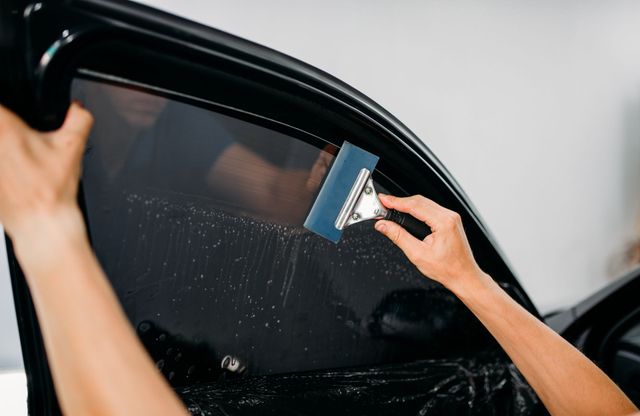Moro Auto Spa Window Tinting for Durable UV Protection and Convenience
Moro Auto Spa Window Tinting for Durable UV Protection and Convenience
Blog Article
Your Comprehensive Guide to DIY Window Tinting: Idea
Taking on a Do it yourself home window tinting job offers a possibility to improve both the performance and aesthetic appeals of your room. Prior to getting started on this endeavor, it is essential to navigate the complexities of local tinting laws and choose an ideal movie that aligns with your purposes.
Comprehending Home Window Tinting Regulations
Browsing the complex landscape of window tinting regulations is necessary for any type of do it yourself fanatic looking for to enhance their lorry's appearances and convenience. Each state in the U.S. has specific guidelines regarding the allowed levels of color on different home windows, which can significantly impact your decision-making procedure.
Normally, these legislations dictate the maximum allowed Visible Light Transmission (VLT) percent, which describes the amount of light that can travel through the colored windows. For circumstances, some states permit only a specific percentage of tint on the front windshield, while permitting darker shades on rear windows. Conformity with these regulations is vital, as failing to stick can result in fines or the requirement to eliminate the color altogether.
Furthermore, there are usually differences in between guest lorries and commercial vehicles, with various regulations putting on each category. It's recommended to consult your neighborhood Division of Motor Autos or equivalent authority to collect exact info tailored to your area. Recognizing these legislations not only makes certain lawful compliance but additionally boosts security by maintaining visibility and preventing potential threats while driving.
Selecting the Right Color Film
Choosing the proper tint film is a vital action in the DIY window tinting process, as it directly influences both the appearance and capability of your automobile's windows. Numerous elements need to assist your choice, consisting of the kind of film, its lawful compliance, and your wanted results.
First, consider the various sorts of tint movies available: dyed, metalized, ceramic, and crossbreed. Colored movies supply a fundamental degree of privacy and warmth reduction however might fade gradually. Metalized films provide boosted heat being rejected and sturdiness yet can interfere with digital signals. Ceramic movies, while more costly, give exceptional heat resistance and UV security without signal disturbance.
Next, make sure that the movie abides by neighborhood regulations concerning noticeable light transmission (VLT) percents. Compliance with these legislations is essential to stay clear of penalties and make certain safety and security.
Important Tools for Do It Yourself Tinting
Having selected the appropriate color movie for your windows, the next step involves collecting the necessary devices to make sure a successful installment. The primary tools you will need include an energy blade or a razor blade, which is important for cutting the tint movie to the wanted dimension. A squeegee is additionally critical, as it aids remove air bubbles and ravel the film during application.

Moreover, take into consideration utilizing a warmth gun or navigate to this site hairdryer, as this can aid mold and mildew the color film to the shapes of the home window and promote adherence. Ultimately, gloves are recommended to avoid fingerprints on the movie during installation. By gathering these essential tools, you will certainly be well-prepared to tackle your DIY home window tinting project properly.
Step-by-Step Application Refine
Begin by extensively cleaning the home window surface to make certain ideal bond of the color movie. Use a glass cleaner and a lint-free cloth to eliminate any type of dirt, dirt, or oil. As soon as the home window is clean, gauge the tint movie versus the window, permitting for a small overlap on all sides. Cut the movie appropriately with a sharp energy knife for a specific fit.
Gently spray the window surface and the sticky side of the movie. Meticulously align the film with the top of the window, guaranteeing it is right. Make use of a squeegee to smooth the film, applying firm, even pressure.
Enable the tint to treat for at least 24 hours without rolling down the windows. Comply with these steps carefully for ideal results in your DIY window tinting project.
Maintenance and Treatment Tips

It's a good idea to wait best site a minimum of a week after setup before cleaning your windows to permit Your Domain Name the glue to totally treat. During this preliminary duration, stay clear of rolling down the home windows to avoid any damage to the color.
Normal maintenance involves examining the edges of the color for any type of indications of bubbling or raising. If you observe any type of issues, it's ideal to resolve them immediately to avoid more damage. In addition, be careful with the use of home window treatments, such as shades or drapes, as they can produce heat that could jeopardize the tint in time.
Verdict
Finally, embarking on a DIY home window tinting job necessitates careful factor to consider of neighborhood laws, selection of proper tint movies, and the use of important tools. A systematic application procedure makes sure optimum results, while regular upkeep adds to the longevity of the tint - Moro Auto Spa Window Tinting. By sticking to these standards, people can attain both aesthetic enhancement and enhanced personal privacy in their areas, making do it yourself window tinting a useful venture
Report this page